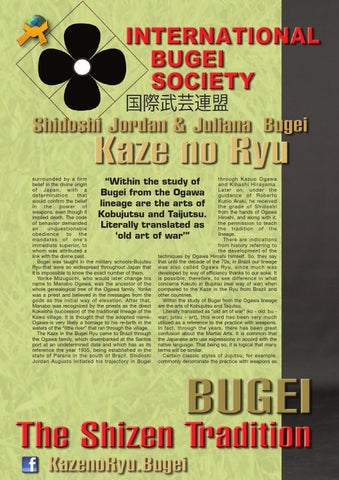surrounded by a firm belief in the divine origin of Japan, with a determination that would confirm the belief in the power of weapons, even though it implied death. The code of behavior demanded an unquestionable obedience to the mandates of one's immediate superior, to whom was attributed a link with the divine past. Bugei was taught in the military schools-Bujutsu Ryu-that were so widespread throughout Japan that it is impossible to know the exact number of them. Yorike Mizuguchi, who would later change his name to Manabo Ogawa, was the ancestor of the whole genealogical tree of the Ogawa family. Yorike was a priest and believed in the messages from the gods as the initial way of elevation. After that, Manabo was recognized by the priests as the direct Kokeisha (successor) of the traditional lineage of the Kawa village. It is thought that the adopted nameOgawa-is very likely a homage to his re-birth in the waters of the “little river” that ran through the village. The Kaze in the Bugei Ryu came to Brazil through the Ogawa family, which disembarked at the Santos port at an undetermined date and which has as its reference the year 1935, being established in the state of Parana in the south of Brazil. Shidoshi Jordan Augusto initiated his trajectory in Bugei
through Kazuo Ogawa and Kibashi Hirayama. Later on, under the guidance of Roberto Kunio Araki, he received the grade of Shidoshi from the hands of Ogawa Hiroshi, and along with it, the permission to teach the tradition of the lineage. There are indications from history referring to the development of the techniques by Ogawa Hiroshi himself. So, they say that until the decade of the 70s, in Brazil our lineage was also called Ogawa Ryu, since much was developed by way of efficiency thanks to our soke. It is possible, therefore, to see difference in what concerns Kakuto in Bujutsu (real way of war) when compared to the Kaze in the Ryu from Brazil and other countries. Within the study of Bugei from the Ogawa lineage are the arts of Kobujutsu and Taijutsu. Literally translated as “old art of war” (ko - old; bu war; jutsu - art), this word has been very much utilized as a reference to the practice with weapons. In fact, through the years, there has been great confusion about the Martial Arts. It is common that the Japanese arts use expressions in accord with the native language. That being so, it is logical that many terms will be similar. Certain classic styles of Jujutsu, for example, commonly denominate the practice with weapons as
“Within the study of Bugei from the Ogawa lineage are the arts of Kobujutsu and Taijutsu. Literally translated as ‘old art of war’”
